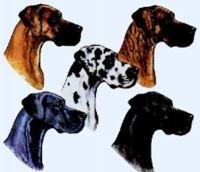Nowadays the Great Dane is being bred in five accepted colours: Harlequin (black and white), black, blue, fawn and brindle. These colours, however, cannot be interbred arbitrarily. They are combined in three groups or colour varieties: Harlequin and black, blue, fawn and brindle. Of all colours the Harlequin is without a doubt the most difficult one for breeding. Quite often this breed is jokingly called the breed for millionaires. To a certain extent, breeding this colour is a lottery for the breeders. The interbreeding of well-dabbled parent dogs may quite possibly produce an offspring of only black puppies or even so-called faulty colours, which we call grey tigers, porcelain tigers and albinos. We kindly ask the reader to look up the details in the characteristics of the breed. We do not intend to examine as to why this is possible. The hereditary of colours and, what is more important for this colour, the Merle-factor, are a matter for specialists.
The fawn/ brindle colour is “relatively” easy to breed. The outcome of a litter in this respect can be pre-determined. Pairing two fawns will always produce a fawn offspring which simply show different shades of fawn. This is called recessive genetic traits since both parent animals only have genes of this colour. According to the experiences of breeders, the colour will start to fade when only breeding with dogs of the same colour over and over again.
Therefore you are supposed to cross-breed regularly fawn and brindle dogs in order to achieve a freshening up of the pigments. The litter can be expected to have fawn and brindle puppies. Usually, if you mate two brindles, there will be fawn and brindle puppies. Breeders who only pair brindle Danes should be aware of the fact that the black streams will be more and more dense and the leftover ground colour will be pale or ash-grey. Both are unsightly, therefore it is recommended to also mate fawn and brindle on a regular basis. If you, as a buyer, are going to have a look at newly born brindle puppies don’t be scared off. The little ones have a muddy-ash-grey colour at first and mostly a black line on their backs; but as they get older the colour and markings become clearer.
 Likewise as the fawn Danes, the blue ones also have only one pigment. A pair of blue will therefore always produce blue puppies. In the past, with only a small stock of breed, this caused problems of inbreeding. Therefore it was a common practice to cross-breed the fawn color from time to time. Through this method – although in a well-dispensed manner – faults have been eliminated and the result was an improvement for this type of coloring. In the past, you would have only come across blue Danes with a very slender body and a dainty, almost Doberman-like head. But nowadays you will find many Danes with an elegant body and a prominent head like usually predominate among the fawn/ brindle colors. A so-called fawn cross-breed produces a black offspring in the first generation. These black animals are specially marked on the genealogy and must only be used for blue color breeding. In terms of breeding they must not be confused with the black Danes of a brindle breed.
Likewise as the fawn Danes, the blue ones also have only one pigment. A pair of blue will therefore always produce blue puppies. In the past, with only a small stock of breed, this caused problems of inbreeding. Therefore it was a common practice to cross-breed the fawn color from time to time. Through this method – although in a well-dispensed manner – faults have been eliminated and the result was an improvement for this type of coloring. In the past, you would have only come across blue Danes with a very slender body and a dainty, almost Doberman-like head. But nowadays you will find many Danes with an elegant body and a prominent head like usually predominate among the fawn/ brindle colors. A so-called fawn cross-breed produces a black offspring in the first generation. These black animals are specially marked on the genealogy and must only be used for blue color breeding. In terms of breeding they must not be confused with the black Danes of a brindle breed.